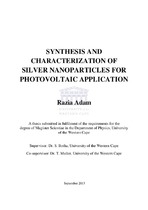| dc.description.abstract | With an increase in the amount of harmful carbon emissions in the atmosphere as well as a decrease in the availability of fossil fuels, there is a relatively high demand for alternate energy devices. Solar cells have become an alternative option in aid of leading the way for clean energy; however these devices are relatively expensive and have an efficiency that is relatively low in comparison to that of fossil fuelled energy. As a result the cost of the solar cell needs to be reduced by reducing the amount of silicon used in order to compete with fossil fuelled devices; however this decrease would lead to a decrease in efficiency. In recent years silver nanoparticles have been extensively researched as a result of its extraordinary optical, electrical, catalytic, magnetic and antibacterial properties. As a result of these properties, the nanoparticles may be applied to many research areas such as photovoltaics, catalysis and medical fields. The optical properties of silver nanoparticles may thus be exploited in order to increase absorption and in turn the efficiency of the solar cell devices. This study focuses on the optimization of the polyol synthesis to possibly obtain uniformly dispersed silver nanoparticles. The silver nanoparticles would then be incorporated onto amorphous silicon thin films, deposited by hot wire chemical vapour deposition, by spraying a suspension of the silver nanoparticles onto the thin films. The silver nanoparticles were viii characterized by Ultra Violet Visible Spectroscopy (UV-VIS), High Resolution Transmission Electron Microscopy, X-ray Diffraction, and Thermogravimetric Analysis. The thin films with the incorporated silver nanoparticles were characterized by UV-VIS, and High Resolution Scanning Electron Microscopy. It was shown that silver nanoparticles with various morphologies were produced by the polyol synthesis and may be used to enhance light trapping of thin film
photovoltaic devices. | en_US |

